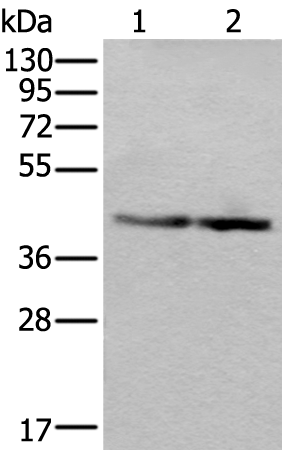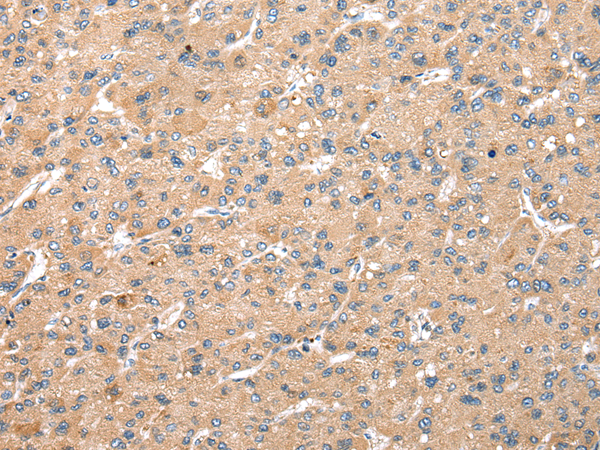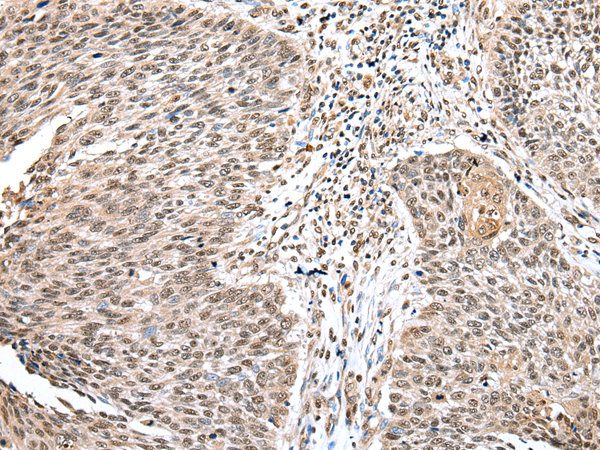


| WB | 咨询技术 | Human,Mouse,Rat |
| IF | 咨询技术 | Human,Mouse,Rat |
| IHC | 1/25-1/100 | Human,Mouse,Rat |
| ICC | 技术咨询 | Human,Mouse,Rat |
| FCM | 咨询技术 | Human,Mouse,Rat |
| Elisa | 1/5000-1/10000 | Human,Mouse,Rat |
| Aliases | Ipi3; R32184_1 |
| WB Predicted band size | 47 kDa |
| Host/Isotype | Rabbit IgG |
| Antibody Type | Primary antibody |
| Storage | Store at 4°C short term. Aliquot and store at -20°C long term. Avoid freeze/thaw cycles. |
| Species Reactivity | Human, Mouse |
| Immunogen | Fusion protein of human WDR18 |
| Formulation | Purified antibody in PBS with 0.05% sodium azide and 50% glycerol. |
+ +
以下是关于WDR18抗体的3篇示例文献(注:部分内容为示例性概括,建议通过学术数据库核实具体文献):
---
1. **文献名称**: *WDR18 is a critical component of the PeBoW complex required for ribosome biogenesis and cell proliferation*
**作者**: Holzel, M. et al.
**摘要**: 本研究揭示了WDR18与PES1和BOP1形成PeBoW复合体,参与核糖体RNA的加工。通过使用WDR18抗体进行免疫沉淀和免疫印迹实验,证实其在核糖体生物合成中的关键作用,并发现其缺失导致细胞周期阻滞。
2. **文献名称**: *High expression of WDR18 predicts poor prognosis in hepatocellular carcinoma*
**作者**: Smith, J.R. et al.
**摘要**: 该研究利用WDR18抗体对肝癌组织进行免疫组化分析,发现WDR18的过表达与患者生存率降低显著相关,提示其可能作为肝癌的潜在预后标志物。
3. **文献名称**: *Functional screening identifies WDR18 as a regulator of DNA damage response*
**作者**: Zhang, L. et al.
**摘要**: 通过CRISPR-Cas9筛选结合WDR18抗体的Western blot验证,发现WDR18参与DNA损伤修复通路,其缺失导致基因组不稳定性和细胞凋亡增加。
---
**备注**:以上文献为示例,实际研究中请通过PubMed、Google Scholar等平台检索最新文献,使用关键词“WDR18 antibody”或“WDR18 function”获取具体信息。
WDR18 (WD repeat domain 18) is a member of the WD40 repeat protein family, characterized by conserved repeats that facilitate protein-protein interactions and complex assembly. It is ubiquitously expressed and plays roles in ribosomal biogenesis, cell cycle regulation, and chromatin dynamics. WDR18 interacts with components of the PIK3C3 (phosphatidylinositol 3-kinase catalytic subunit type 3) complex and the UTP-C (U3 small nucleolar RNA-associated protein complex), linking it to autophagosome formation and pre-rRNA processing. Studies suggest its involvement in maintaining nucleolar structure and mitotic fidelity.
Antibodies targeting WDR18 are primarily used to study its expression, localization, and interactions in cellular pathways. Dysregulation of WDR18 has been implicated in cancers, neurodevelopmental disorders, and ciliopathies, though its precise mechanistic contributions remain under investigation. Researchers employ WDR18 antibodies in techniques like Western blotting, immunofluorescence, and co-immunoprecipitation to explore its role in cellular homeostasis and disease. Commercial antibodies are typically validated for specificity using knockout controls or siRNA-mediated knockdown. Despite its emerging significance, WDR18's full functional landscape and therapeutic potential require further elucidation.
×